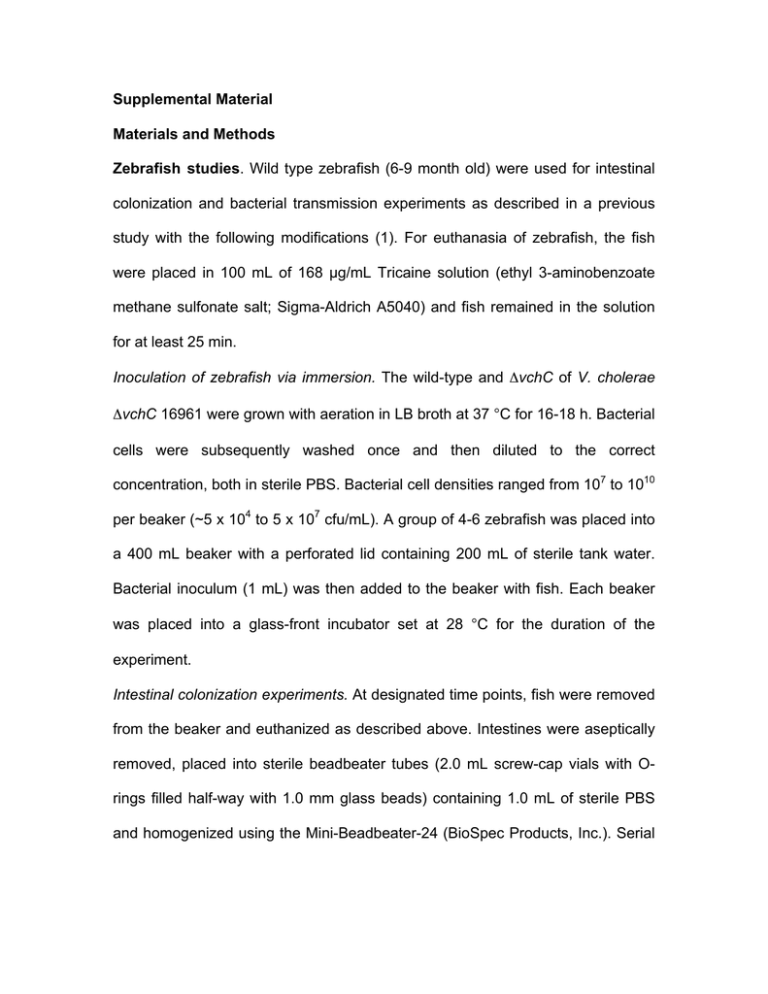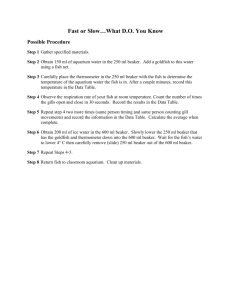Supplemental Material Materials and Methods Zebrafish studies
advertisement

Supplemental Material Materials and Methods Zebrafish studies. Wild type zebrafish (6-9 month old) were used for intestinal colonization and bacterial transmission experiments as described in a previous study with the following modifications (1). For euthanasia of zebrafish, the fish were placed in 100 mL of 168 µg/mL Tricaine solution (ethyl 3-aminobenzoate methane sulfonate salt; Sigma-Aldrich A5040) and fish remained in the solution for at least 25 min. Inoculation of zebrafish via immersion. The wild-type and ΔvchC of V. cholerae ΔvchC 16961 were grown with aeration in LB broth at 37 °C for 16-18 h. Bacterial cells were subsequently washed once and then diluted to the correct concentration, both in sterile PBS. Bacterial cell densities ranged from 107 to 1010 per beaker (~5 x 104 to 5 x 107 cfu/mL). A group of 4-6 zebrafish was placed into a 400 mL beaker with a perforated lid containing 200 mL of sterile tank water. Bacterial inoculum (1 mL) was then added to the beaker with fish. Each beaker was placed into a glass-front incubator set at 28 °C for the duration of the experiment. Intestinal colonization experiments. At designated time points, fish were removed from the beaker and euthanized as described above. Intestines were aseptically removed, placed into sterile beadbeater tubes (2.0 mL screw-cap vials with Orings filled half-way with 1.0 mm glass beads) containing 1.0 mL of sterile PBS and homogenized using the Mini-Beadbeater-24 (BioSpec Products, Inc.). Serial dilutions of the homogenate were plated on LB agar containing streptomycin and 40 µg/mL X-gal for enumeration. Transmission experiments. A group of 4-6 zebrafish, anesthetized and fin-clipped for later identification, was placed in a 600 mL beaker with 300 mL tank water. A second group of 4-6 zebrafish was exposed to 107-109 V. cholerae in 200 ml tank water as described above. After 2-3 h, the exposed fish were moved to another beaker of fresh tank water twice to remove external V. cholerae. These infected fish were then placed in the beaker holding the fin-clipped naive zebrafish. After 24 h all of the fish were sacrificed and intestinal V. cholerae were enumerated as described above. Infant mouse studies. Five-day-old CD-1 mouse pups were used for intestinal colonization assays. The pups were inoculated by gavage with 50 µL V. cholerae suspension containing approximately 106 total bacteria. Infected pups were then incubated at 30˚ C for 20 h. The mice were euthanized by decapitation, intestines were dissected aseptically and placed into sterile beadbeater tubes (2.0 mL screw-cap vials with O-rings filled half-way with 1.0 mm glass beads) containing 1.0 mL of sterile LB and homogenized using the Mini-Beadbeater-24 (BioSpec Products, Inc.). Serial dilutions of the intestinal homogenates were plated on LB agar containing 10 µg/mL streptomycin and 20 µg/ml X-Gal and incubated at 37 ˚ C for 24 hours before enumeration of bacterial colonies. Ethics statement. All animal studies were carried out in accordance with the recommendations in the Guide for the Care and Use of Laboratory Animals of the National Institutes of Health. All animal work was conducted according to the relevant guidelines of the Public Health Service, Office of Laboratory Animal Welfare, Animal Assurance no. A3310-01, and was approved by the Wayne State University IACUC, protocol number A 01-14-10. TABLES Table S1. Strains and plasmids used in this study Strain/plasmid Description/relevant genotype1 Reference/source V. cholerae strains N16961 Wild-type El Tor O1 biotype, Sm R Laboratory collection NΔeps N16961 ΔepsC-N, CmR (2) ΔvchC N16961 ΔvchC::cat, CmR This study E. coli strains F− araD139 Δ(ara-leu)7697 Δ(lac)X74 MC1061 (3) rpsL hsdR2 mcrA mcrB1 MM294 Donor of transfer function for triparental (pRK2013) conjugation (4) Plasmids pMMB67-EH Expression vector, PTAC promoter, AmpR (5) Expression vector, FRT-cat-FRT, R6K pKD3 R promoter, Amp , Cm R (6) pPCR-Script Cloning vector Stratagene pCVD442 ori R6K mobRP4 sacB, AmpR (7) vchC cloned into pCRScript, AmpR This study pPCR-ScriptVchC pPCR- pPCR-Script-VchC containing cat cassette vchC::cat inserted into vchC gene This study pΔvchC vchC::cat from cloned into pCVD442 This study pVchC pMMB67-EH carrying PTAC-VchC This study pMMB67-EH carrying recombinant VchC pVchC-His with C-terminal 6×His cloned under PTAC This study control pVchC-H435A pMMB67-EH carrying PTAC-VchC-H435A This study pVchC-E436A pMMB67-EH carrying PTAC-VchC-E436A This study pVchC-H439A pMMB67-EH carrying PTAC-VchC-E439A This study 1 R R R Sm , streptomycin resistant; Amp , ampicillin resistant; Cm , chloramphenicol resistant Table S2. Oligonucleotide primers designed and used in this study Name Sequence (5’ to 3’) Primers for cloning wild-type alleles1: VchCF GAATTCCATCATAAATAGGTTTTGCAGTGGTC VchCR CTGCAGTCAGTCGAAATAGGCCACCAT rVchCF GAGCTCGAATTCCATCATAAATAGGTTTTGCAGTGTC CTGCAGTCTAGACACCACCACCACCACCACTAAGAAGTCGAAA rVchCR TAGGCCACCATTT Primers for creating NΔvchC knockout strain: CmF CATATGCCATGGTGTGTAGGCTGGAGCTGCTT CmR CATATGCCATGGCATATGAATATCCTCCTTAG Primers for site-directed mutagenesis: H435F ATTTGTCGATTCTCAATTTAGAGGCTGAGTACACTCATTATCTG GACG CGTCCAGATAATGAGTGTACTCAGCCTCTAAATTGAGAATCGAC H435R AAAT E436F GATTCTCAATTTAGAGCATGCGTACACTCATTATCTGGACG E436R CGTCCAGATAATGAGTGTACGCATGCTCTAAATTGAGAATC H439F TTTAGAGCATGAGTACACTGCTTATCTGGACGCGCGCTTC H439R GAAGCGCGCGTCCAGATAAGCAGTGTACTCATGCTCTAAA 1 2 F, forward; R, reverse underlined nucleotides refer to restriction enzyme sites Figures Figure S1. associated The with extracellular a functional collagenolytic/gelatinolytic T2SS. (A) Detection of activity is extracellular collagenolytic/gelatinolytic activity was performed by separating supernatants harvested at late stationary phase of growth (16 h) from wt V. cholerae N16961 and isogenic mutants N∆eps as well as ∆vchC in 10% Tris-glycine gel copolymerized with 0.1% gelatin. Samples were matched by equivalent OD600 units. (B) The proteolytic activity against DQ gelatin was examined in supernatants isolated from late stationary cultures of wt V. cholerae N16961, isogenic T2S mutants: N∆eps and N∆epsD, as well as complemented strains N∆eps pEps and N∆epsD pEpsD. The mean ± SEM are presented (n=4). Figure S2. The lack of VchC does not significantly contribute to the V. cholerae N16961 ability to colonize mouse (A) and zebra fish (B) intestine nor to the transmission between infected and naive fish (C). (A) To study the impact of VchC on V. cholerae intestinal colonization in the mammalian host, an infant mouse model has been utilized. In the biological replicate experiments, groups of six CD-1 mouse pups were separately inoculated with either the wt N16961 strain or the isogenic ΔvchC mutant (106 of bacteria). Following 20 h, the mice were euthanized, their intestines were homogenized and the bacteria were recovered by plating the homogenates on LB agar containing streptomycin and X-gal. (B, C) A group of 4-6 wild type zebra fish was placed into a beaker followed by the addition of either wt V. cholerae N16961 or isogenic ∆vchC (5 ×104 - 5 ×107 CFU/mL). In the intestinal colonization studies, fish were removed from the beakers after 24 h and euthanized. Homogenates of their intestines were plated on LB agar to enumerate bacterial loads. In the transmission experiments, a group of 4-6 fin-clipped zebrafish was used as naive fish whereas a second group of 4-6 zebrafish was exposed to 107-109 of V. cholerae (wt or ∆vchC). After removal of the external V. cholerae, the infected fish were placed into the dish containing the naive group. The fish were sacrificed after 24 h and the bacteria were enumerated as described above. Figure S3. V. cholerae utilizes type I fish collagen as a source of nutrients for proliferation and growth. Suspensions (103 CFU/mL) of the parental wt p, ∆vchC p, and ∆vchC pVchC of V. cholerae N16961 were separately inoculated into M9 salts media supplemented with either 0.4% fish collagen or casamino acids and 0.4% glucose (as indicated). Bacterial cultures were maintained with aeration at either 25 °C or 37 °C and samples were withdrawn and plated onto LB agar every 24 h to assess CFU. Experiments were performed in biological quadruplicates and means with corresponding SEMs are presented. The statistical significance was assessed using Mann-Whitney test (p<0.05). (B) The supernatants were isolated from bacterial cultures at 48 h of growth, concentrated 40-fold using centrifugal 0.5-mL filter with a molecular weight cut-off of 10 kDa, and examined by in-gel zymography using 10% Tris-glycine gel copolymerized with 0.1% gelatin. REFERENCES 1. Runft DL, Mitchell KC, Abuaita BH, Allen JP, Bajer S, Ginsburg K, Neely MN, Withey JH. 2014. Zebrafish as a natural host model for Vibrio cholerae colonization and transmission. Appl. Environ. Microbiol. 80:17101717. 2. Sikora AE, Lybarger SR, Sandkvist M. 2007. Compromised outer membrane integrity in Vibrio cholerae Type II secretion mutants. J. Bacteriol. 189:8484-8495. 3. Casadaban MJ, Cohen SN. 1980. Analysis of gene control signals by DNA fusion and cloning in Escherichia coli. J. Mol. Biol. 138:179-207. 4. Meselson M, Yuan R. 1968. DNA restriction enzyme from E. coli. Nature 217:1110-1114. 5. Furste JP, Pansegrau W, Frank R, Blocker H, Scholz P, Bagdasarian M, Lanka E. 1986. Molecular cloning of the plasmid RP4 primase region in a multi-host-range tacP expression vector. Gene 48:119-131. 6. Datsenko KA, Wanner BL. 2000. One-step inactivation of chromosomal genes in Escherichia coli K-12 using PCR products. Proc. Natl. Acad. Sci. USA 97:6640-6645. 7. Donnenberg MS, Kaper JB. 1991. Construction of an eae deletion mutant of enteropathogenic Escherichia coli by using a positive-selection suicide vector. Infect. Immun. 59:4310-4317.



